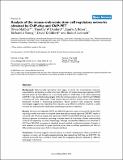| dc.contributor.author | Mathur, Divya | |
| dc.contributor.author | Young, Richard A. | |
| dc.contributor.author | Jaenisch, Rudolf | |
| dc.contributor.author | Danford, Timothy William | |
| dc.contributor.author | Boyer, Laurie Ann | |
| dc.contributor.author | Gifford, David K | |
| dc.date.accessioned | 2010-10-12T14:45:31Z | |
| dc.date.available | 2010-10-12T14:45:31Z | |
| dc.date.issued | 2008-08 | |
| dc.date.submitted | 2008-06 | |
| dc.identifier.issn | 1465-6906 | |
| dc.identifier.uri | http://hdl.handle.net/1721.1/59018 | |
| dc.description.abstract | Background: Genome-wide approaches have begun to reveal the transcriptional networks responsible for pluripotency in embryonic stem (ES) cells. Chromatin Immunoprecipitation (ChIP) followed either by hybridization to a microarray platform (ChIP-chip) or by DNA sequencing (ChIP-PET), has identified binding targets of the ES cell transcription factors OCT4 and NANOG in humans and mice, respectively. These studies have provided an outline of the transcriptional framework involved in maintaining pluripotency. Recent evidence with comparing multiple technologies suggests that expanding these datasets using different platforms would be a useful resource for examining the mechanisms underlying pluripotency regulation. Results: We have now identified OCT4 and NANOG genomic targets in mouse ES cells by ChIP-chip and provided the means to compare these data with previously reported ChIP-PET results in mouse ES cells. We have mapped the sequences of OCT4 and NANOG binding events from each dataset to genomic coordinates, providing a valuable resource to facilitate a better understanding of the ES cell regulatory circuitry. Interestingly, although considerable differences are observed in OCT4 and NANOG occupancy as identified by each method, a substantial number of targets in both datasets are enriched for genes that have known roles in cell-fate specification and that are differentially expressed upon Oct4 or Nanog knockdown. Conclusion: This study suggests that each dataset is a partial representation of the overall ES cell regulatory circuitry, and through integrating binding data obtained by ChIP-chip and ChIP-PET, the methods presented here provide a useful means for integrating datasets obtained by different techniques in the future. | en_US |
| dc.description.sponsorship | National Institutes of Health (U.S) ( RO1-HD045022 ) | en_US |
| dc.description.sponsorship | National Institutes of Health (U.S) (R37-CA084198) | en_US |
| dc.description.sponsorship | National Institutes of Health (U.S) ( HG002688 ) | en_US |
| dc.publisher | BioMed Central Ltd | en_US |
| dc.relation.isversionof | http://dx.doi.org/10.1186/gb-2008-9-8-r126 | en_US |
| dc.rights | Creative Commons Attribution | en_US |
| dc.rights.uri | http://creativecommons.org/licenses/by/2.0 | en_US |
| dc.source | BioMed Central Ltd | en_US |
| dc.title | Analysis of the mouse embryonic stem cell regulatory networks obtained by ChIP-chip and ChIP-PET | en_US |
| dc.type | Article | en_US |
| dc.identifier.citation | Genome Biology. 2008 Aug 13;9(8):R126 | en_US |
| dc.contributor.department | Massachusetts Institute of Technology. Computer Science and Artificial Intelligence Laboratory | en_US |
| dc.contributor.department | Massachusetts Institute of Technology. Department of Biology | en_US |
| dc.contributor.department | Massachusetts Institute of Technology. Department of Electrical Engineering and Computer Science | en_US |
| dc.contributor.department | Whitehead Institute for Biomedical Research | en_US |
| dc.contributor.mitauthor | Mathur, Divya | |
| dc.contributor.mitauthor | Danford, Timothy William | |
| dc.contributor.mitauthor | Boyer, Laurie | |
| dc.contributor.mitauthor | Young, Richard A. | |
| dc.contributor.mitauthor | Gifford, David K. | |
| dc.contributor.mitauthor | Jaenisch, Rudolf | |
| dc.relation.journal | Genome Biology | en_US |
| dc.eprint.version | Final published version | en_US |
| dc.identifier.pmid | 18700969 | |
| dc.type.uri | http://purl.org/eprint/type/JournalArticle | en_US |
| eprint.status | http://purl.org/eprint/status/PeerReviewed | en_US |
| dc.date.updated | 2010-09-03T16:01:20Z | |
| dc.language.rfc3066 | en | |
| dc.rights.holder | Mathur et al.; licensee BioMed Central Ltd. | |
| dspace.orderedauthors | Mathur, Divya; Danford, Timothy W; Boyer, Laurie A; Young, Richard A; Gifford, David K; Jaenisch, Rudolf | en |
| dc.identifier.orcid | https://orcid.org/0000-0001-8855-8647 | |
| dc.identifier.orcid | https://orcid.org/0000-0003-1709-4034 | |
| dc.identifier.orcid | https://orcid.org/0000-0003-3491-4962 | |
| mit.license | PUBLISHER_CC | en_US |
| mit.metadata.status | Complete | |
